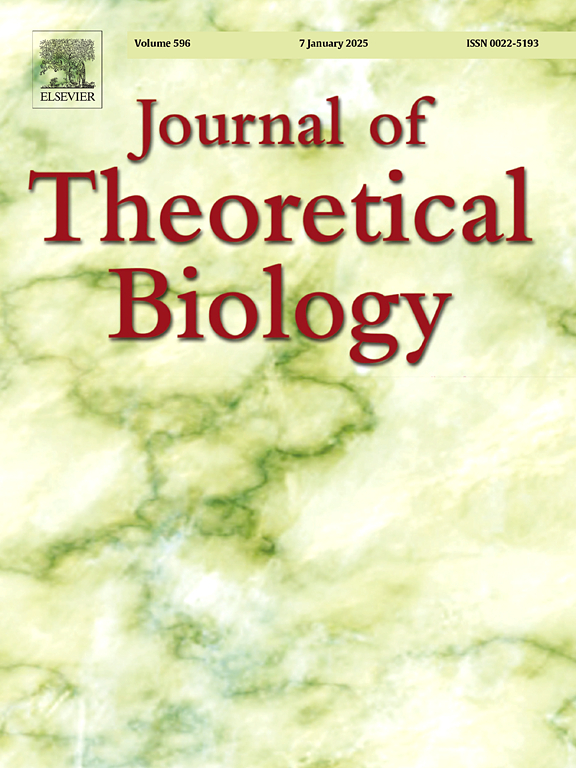采用达芬振荡器的资源预算模型,用于研究阆中同步两年生橄榄的动态。
IF 1.9
4区 数学
Q2 BIOLOGY
引用次数: 0
摘要
我们建立并分析了一个时间连续的空间块状资源预算模型,以解释黎凡特地区同步两年生橄榄的动态变化,特别侧重于该地区最重要的橄榄生产国叙利亚。该模型是著名资源预算模型的时间连续对应模型。它由一个达芬振荡器和一个授粉动力学模型组成,外力通过光合作用推动橄榄生长。参考数据来自国际组织的统计数据库和我们在叙利亚邻国约旦的观测系统,为完善模型结构提供了丰富的信息。对叙利亚现代历史的深入研究涉及到农业政策和社会稳定的重大转变,由此得出结论,模型应将橄榄产量与社会政治因素相互作用的反常现象理解为一种自主行为。传统数学方法分析了模型的特征,如解的非负性、有界性和稳定性。该系统在授粉淡季是稳定的,但在授粉旺季可能会变得不稳定和无约束,这是时间离散资源预算模型无法再现的特性。一个重要的发现是,单棵果树通过无花授粉耦合并不是同步的必要条件,这推翻了之前的文献研究。最适合叙利亚橄榄产量历史数据的模型参数值导致了有界混沌。在其他参数值的作用下,模型可能会表现出周期性振荡、不稳定性或炸毁,这在分岔图中可以清楚地看到。本文章由计算机程序翻译,如有差异,请以英文原文为准。
Resource budget model with Duffing oscillator for dynamics of synchronized biennial-bearing olives in the Levant
We develop and analyze a temporally continuous spatially lumped resource budget model to explain the dynamics of synchronized biennial-bearing olives in the Levant, specifically focusing on Syria, the region’s foremost olive-producing country. The model is a time-continuous counterpart of the celebrated resource budget model. It consists of a Duffing oscillator coupled with a dynamical model of pollination with an external force propelling olive growth by photosynthesis. The reference data are obtained from statistical databases of international organizations and our own observation systems in Jordan, a country neighboring Syria, providing a wealth of information to refine the model structure. An intensive review of Syria’s modern history involving significant shifts in agricultural policy and social stability leads to a conclusion that the model should comprehend the anomaly of olive yield interacting with socio-political factors as an autonomous behavior. The conventional mathematical methodology analyzes the model’s characteristics, such as solutions’ non-negativity, boundedness, and stability. The system is stable during pollination off-season but may become unstable and unbounded during pollination on-season, which is a property that the time-discrete resource budget model cannot reproduce. A significant finding is that coupling individual fruit trees by anemophily is not essential in synchronization, overturning earlier studies in the literature. The values of model parameters that best fit the historical data of olive yield in Syria result in bounded chaos. With alternative parameter values, the model could exhibit periodic oscillation, instability, or blowing up, as clearly shown in bifurcation diagrams.
求助全文
通过发布文献求助,成功后即可免费获取论文全文。
去求助
来源期刊
CiteScore
4.20
自引率
5.00%
发文量
218
审稿时长
51 days
期刊介绍:
The Journal of Theoretical Biology is the leading forum for theoretical perspectives that give insight into biological processes. It covers a very wide range of topics and is of interest to biologists in many areas of research, including:
• Brain and Neuroscience
• Cancer Growth and Treatment
• Cell Biology
• Developmental Biology
• Ecology
• Evolution
• Immunology,
• Infectious and non-infectious Diseases,
• Mathematical, Computational, Biophysical and Statistical Modeling
• Microbiology, Molecular Biology, and Biochemistry
• Networks and Complex Systems
• Physiology
• Pharmacodynamics
• Animal Behavior and Game Theory
Acceptable papers are those that bear significant importance on the biology per se being presented, and not on the mathematical analysis. Papers that include some data or experimental material bearing on theory will be considered, including those that contain comparative study, statistical data analysis, mathematical proof, computer simulations, experiments, field observations, or even philosophical arguments, which are all methods to support or reject theoretical ideas. However, there should be a concerted effort to make papers intelligible to biologists in the chosen field.

 求助内容:
求助内容: 应助结果提醒方式:
应助结果提醒方式:


